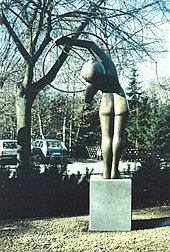Werner Homuth
Werner Homuth (born March 23, 1934 in Lübeck ; † September 10, 2008 in Bad Segeberg ) was a German building designer, sculptor, graphic artist and restorer.
Life
Werner Homuth was born in Lübeck in 1934 as the son of a musician. There he attended the Oberschule zum Dom from 1944 to 1952. From 1946 to 1949 the painter Wilhelm Neckel (1892–1991) was his art teacher. He preferred the musical subjects, took piano, organ and composition lessons. In 1952, however, he decided on the fine arts and did an apprenticeship as a building and font painter, which he finished in 1955 with distinction. He was the state winner in the performance competition of the German craft youth.
During his time as a journeyman, he took painting and drawing courses at the adult education center before he began studying applied painting at the Muthesius-Werkschule in 1958 (with Hubert Schmittler and Gottfried Brockmann, among others), which he completed in 1961 with a state exam.
From 1961 he created as a freelance artist - often as a commission for "Art in Architecture" - wall reliefs in various techniques, statues, church windows and representative advertising graphics. From 1975 Homuth reflected on his musical talent, trained as a church musician, composed and played church music. In addition to the creative works on the building, there was an increasing number of orders for the restoration of sculptures (see also photo above) and historical works of art such as the astronomical clock of St. Marien in Lübeck.
In 2008 Werner Homuth died in Bad Segeberg.
In 2014, his partner and heiress Maria Jentsch donated Homuth's legacy to the “ Forum for Artists' Legacies eV” in Hamburg-Niendorf: small sculptures and graphics.
plant
Werner Homuth was first and foremost an “artist in building”: he designed picture windows, wall reliefs, statues or objects for outdoor facilities in a successful coordination of material, shape, space and purpose of the space. He was able to give concrete, bronze, glass, polyester and brick shapes that were appropriate to the material and determined the space. The different works “sufficiently testify to Homuth's clear and strict conception of form, his drawing and compositional skills, which are based on and controlled by nature and the model. Since he comes from the craft training, knowledge and mastery of materials is a matter of course for him. On the other hand, since he always has the building, the architecture as a whole, in mind, he is following the fundamental demands of Walter Gropius, who saw building as the ultimate goal of all artistic activity. "
How closely his form, subject and material correspond can be seen most clearly in his sculptures. The life-size bronze figures "The Flute Player" in Glückstadt (1976) and "Tire Gymnastics" in Pansdorf (1982) refer to Homuth's admiration for Ernst Barlach. With reduced lines in the form, a theme-specific dynamic develops. “Die Ballspielerin” made of concrete conveys the power inherent in the action in an “icon” -like simplification of the form. In the case of the smaller sculptures (e.g. “Ecce homo” 1972 or “Three Graces” no year) in transparent polyester, the abstraction is complete. That may also be a reason why his sculptures were attested an "outsider position" at some of the annual exhibitions of Lübeck artists.
Quote
In 1996 Werner Homuth describes his pictorial credo: “Art in architecture should take up and enhance the lines of tectonics. In line with the Bauhaus idea, I endeavor to carry out my designs, which have to be based on the material, as much as possible myself, since the craftsman does not think and see artistically. Every job is different in terms of material and requires the ability to experiment and change. My job would be unthinkable without craftsmanship. "
Exhibitions
- 1970 and 1976: Solo exhibitions in the social parish in Lübeck
- 1970 to at least 1996: Participation in several annual shows of Lübeck artists in the Museum am Dom
Working in public space (selection)
- 1962: Murals at Kiel University Boathouse
- 1963: "Gymnastik" staircase window, Francke School gymnasium in Lübeck
- 1963: Choir window cemetery chapel II Lübeck-Waldhusen
- 1964–66: three material murals in the library near the Lübeck stock exchange hall
- 1963–68: Lettering and coloring on the St. Marien Astronomical Clock in Lübeck
- 1968: Baptistery window "Temptation of Christ" Martin Luther Church Fissau
- 1971–72: Concrete reliefs and "swan fountains" at the Ost Heiligenhafen school
- 1975–76: "Flute Player" Bronze Glückstadt
- 1975: Portal design (copper) Mathias Claudius School Reinfeld
- 1976: Tiles and colored stage wall Forum Realschule Stockelsdorf
- 1978: Plaster inlay in the Pansdorf sports hall
- 1980: World Globe Cesar Klein Comprehensive School Ratekau
- 1982: "Tire gymnastics" (bronze) Pansdorf secondary school
- 1984: Wall design of the sports hall in Ratekau
- 1985: Facade design for elementary and secondary school in Sereetz
- 1986: Spirale sports hall Sereetz
- 2001: small labyrinth brick elementary school Groß Kummerfeld
Web links
Individual evidence
- ^ AB Enns: Werner Homuth . In: Lübecker Nachrichten of July 5, 1970, No. 153, p. 7
- ↑ Jan Herchenröder: Three stations of development . In: Lübecker Nachrichten of April 4, 1979
- ^ Catalog for the annual show of the community of Lübeck painters and sculptors eV 1996 sv Werner Homuth
| personal data | |
|---|---|
| SURNAME | Homuth, Werner |
| BRIEF DESCRIPTION | German building designer, sculptor, graphic artist and restorer |
| DATE OF BIRTH | March 23, 1934 |
| PLACE OF BIRTH | Lübeck |
| DATE OF DEATH | September 10, 2008 |
| Place of death | Bad Segeberg |



